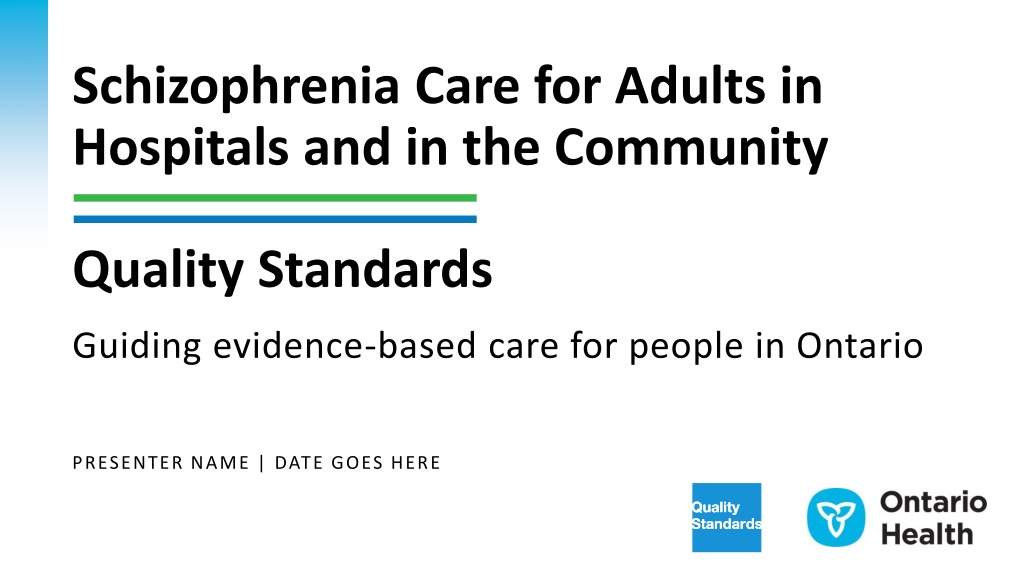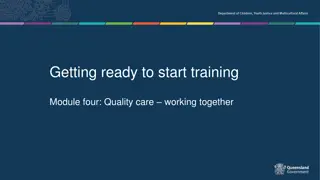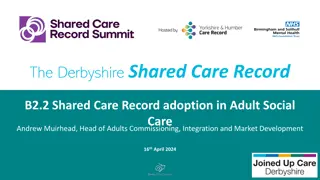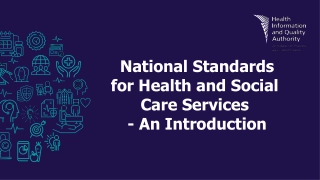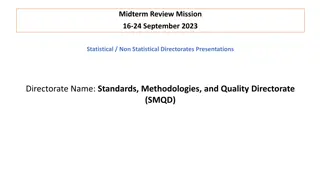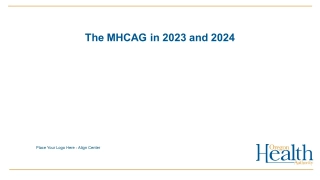Schizophrenia Care Quality Standards in Ontario
Explore the quality standards for schizophrenia care in hospitals and communities in Ontario. Learn about the importance of these standards, key quality statements, and measures to support improvement. Discover resources for clinicians, patients, and organizations to ensure consistent, evidence-based care.
Download Presentation
Please find below an Image/Link to download the presentation.
The content on the website is provided AS IS for your information and personal use only. It may not be sold, licensed, or shared on other websites without obtaining consent from the author. Download presentation by click this link. If you encounter any issues during the download, it is possible that the publisher has removed the file from their server.
Presentation Transcript
Schizophrenia Care for Adults in Hospitals and in the Community Quality Standards Guiding evidence-based care for people in Ontario PRESENTER NAME | DATE GOES HERE
Objectives Overview of quality standards: What are they? How are they used? Why these quality standards are needed: Gaps and variations in quality of care in hospitals and in the community for people with schizophrenia in Ontario Quality statements to improve care: The key statements in the Schizophrenia: Care for Adults in Hospitals and the Schizophrenia: Care for Adults in the Community quality standards Measures to support improvement: Indicators that can help measure your quality improvement efforts 1
Quality standards Inform clinicians and patients what quality care looks like Focus on conditions or processes where there are large variations in how care is delivered, or where there are gaps between the care provided in Ontario and the care patients should receive Are grounded in the best available evidence 2
Quality standards Help health care professionals know what care to offer, based on evidence and expert consensus Help patients, residents, families, and caregivers know what to ask for in their care Help health care organizations measure, assess, and improve the quality of care they provide Help ensure consistent, high-quality care across the province 3
Quality standard resources Placemat Patient Guide Quality Standard Getting Started Guide Measurement Guide Find these resources here: https://hqontario.ca/evidence-to-improve-care/quality-standards/view-all-quality-standards/schizophrenia-care-in-hospital https://hqontario.ca/evidence-to-improve-care/quality-standards/view-all-quality-standards/schizophrenia-care-in-the-community 4
Inside the quality standard The Audience Statements The Quality Statement The Definitions The Indicators 5
Quality standards Patient guide The patient guide is designed to give patients information about what quality care looks like for various conditions based on the best evidence, so they can ask informed questions of their health care providers. 6
Quality Standards Measurement guide The measurement guide has two dedicated sections: Local measurement: what you can do to assess the quality of care that you provide locally Provincial measurement: how we can monitor the progress being made to improve care on a provincial level 7
Quality standards Placemat The placemat is a quick-reference resource for clinicians that summarizes the quality standard and includes links to helpful resources and tools. 8
Quality standards How the health care system can support implementation Implementing quality standards can be challenging owing to system-level barriers or gaps, many of which have been identified throughout the development of this standard Ontario Health will work with and support other provincial partners, including the Ministry of Health, to bridge system-level gaps to support the implementation of quality standards 9
Quality standards Implementation tools The Getting Started Guide: Outlines the process for using the quality standard as a resource to deliver high-quality care Contains evidence-based approaches, as well as useful tools and templates for implementing change ideas at the practice level 10
Quality standard adoption tools Quorum Quorum is an online community dedicated to improving the quality of health care in Ontario. The Quality Standards Adoption Series highlights efforts in the field to implement changes and close gaps in care related to quality standard topics. 11 quorum.hqontario.ca
Why do we need quality standards for schizophrenia? 12
Approximately 1% of people in Ontario have schizophrenia and rates are higher among men (1.2%) than women (0.9%).1 People with schizophrenia often experience increased physical health risks related to their condition and are disproportionately affected by homelessness and precarious housing.2 Sources: 1. 2. Public Health Agency of Canada. Public Health Infobase. Canadian Chronic Disease Surveillance System (CCDSS). Accessed March 2023. Millier A, Schmidt U, Angermeyer MC., Chauhan D, Murthy V, Toumi M, Cadi-Soussi, N. Humanistic burden in schizophrenia: A literature review. Journal of Psychiatric Research. 2014;54:85-93. 13
The proportion of the population with schizophrenia has increased from 2012 to 2019 Incidence and prevalence of schizophrenia in Ontario by fiscal year Prevalence of schizophrenia (%) Incidence of Schizophrenia 150 1.5 (per 100,000 population) 120 1.2 1.01 1.01 1.00 0.99 0.97 0.95 0.93 0.91 90 0.9 60 0.6 55 51 51 51 50 50 49 44 30 0.3 0 0 2012 2013 2014 2015 2016 2017 2018 2019 Fiscal Year Incidence (per 100,000) Prevalence (%) Source: Public Health Agency of Canada. Public Health Infobase. Canadian Chronic Disease Surveillance System (CCDSS). Accessed March 2023. Note: Incidence and prevalence rates are crude rates. 14
All-cause mortality is more than 3 times higher for people with schizophrenia and is increasing over time All-cause mortality in Ontario with and without schizophrenia 3500 3.5 3.13 Mortality Rate per 100,000 2.94 2.83 2.82 2.78 2.77 2.69 2.69 2800 2.8 Rate Ratio 2100 2.1 1400 1.4 700 0.7 0 0 2012 2013 2014 2015 2016 2017 2018 2019 Fiscal Year Mortality Rate with Schizophrenia Mortality Rate without Schizophrenia Rate Ratio Source: Public Health Agency of Canada. Public Health Infobase. Canadian Chronic Disease Surveillance System (CCDSS). Accessed March 2023. Note: Mortality rates are age standardized. 15
Suicide is over 170 times more likely for people with schizophrenia Suicide occurs among 1 out of 58 Ontarians with schizophrenia or related disorders; a rate of 171 per 10,000 people compared to approximately 1 in 10,000 people in the general population.1,2 The risk of death by suicide is higher among men than women and is of greatest risk early in the course of illness, shortly after diagnosis.1 Sources: 1. Zaheer J, Olfson M, Mallia E, Lam JSH, de Oliveira C, Rudoler D, et al. Predictors of suicide at time of diagnosis in schizophrenia spectrum disorder: A 20-year total population study in Ontario, Canada. Schizophrenia Research. 2020;222:382-388. ICES. Suicide rate for people with schizophrenia spectrum disorders 170 times higher than the general population [news release]. June 18, 2020. Toronto. Available from: https://www.ices.on.ca/Newsroom/News-Releases/2020/Suicide-rate-for-people-with-schizophrenia-spectrum- disorders-170-times-higher-than-the-general. 2. 16
Schizophrenia hospitalizations last 14 days on average, compared to an average of 6 days for psychiatric hospitalizations overall. Source: Mental Health and Addictions Program Framework Research Team. Mental health and addictions system performance in Ontario: 2021 Scorecard. Chart Pack. Toronto, ON: ICES; 2021. Available from: https://www.ices.on.ca/Publications/Atlases-and-Reports/2021/Mental-Health- and-Addictions-System-Performance-in-Ontario-2021-Scorecard 17
26.8% of people in Ontario hospitalized for schizophrenia visited a primary care doctor or psychiatrist within a week of their discharge, with threefold variation across Ontario Health Regions Percentage of people who had a visit with a primary care doctor or a psychiatrist within 7 days of a previous hospital discharge for schizophrenia by Ontario Health Region, fiscal year 2021/22 38.2 40 28.2 26.8 30 24.8 23.0 Percent 20 16.6 12.6 10 0 Ontario Toronto Central West East North East North West Sources: Discharge Abstract Database (DAD), Ontario Health Insurance Plan (OHIP) database, Ontario Mental Health Reporting System (OMHRS), Registered Persons Database (RPDB), provided by ICES. Note: Rates are standardized by age and sex.. 18
7-day physician follow-up for schizophrenia, fiscal year 2021/22 People living in urbans areas across Ontario were 1.5 times more likely than those in rural areas to visit a primary care doctor or psychiatrist within a week of their discharge from hospital for schizophrenia. Urban Rural 27.3% 17.5% Rates of 7-day physician follow-up have remained relatively consistent over time between fiscal years 2012/13 and 2021/22. Sources: Discharge Abstract Database (DAD), Ontario Health Insurance Plan (OHIP) database, Ontario Mental Health Reporting System (OMHRS), Registered Persons Database (RPDB), provided by ICES. Note: Rates are standardized by age and sex. 19
16.6% of people in Ontario hospitalized for schizophrenia had a readmission for mental health or addictions within 30 days of discharge, ranging from 13.1% in the North West region to 17.6% in the North East region Percentage of people who had a readmission for mental health or addictions within 30 days of discharge for schizophrenia, in Ontario, by Ontario Health Region, fiscal year 2021/22 20 17.6 17.1 16.6 16.5 16.4 18 16.0 16 13.1 14 Percent 12 10 8 6 4 2 0 Ontario North East West Toronto East Central North West Sources: Discharge Abstract Database (DAD), Ontario Mental Health Reporting System (OMHRS), Registered Persons Database (RPDB), provided by ICES. Note: Rates are standardized by age and sex. 20
There has been a modest decline over time for readmissions for mental health or addictions within 30 days of a hospitalization for schizophrenia in Ontario Percentage of people who had a readmission for mental health or addictions within 30 days of a hospitalization for schizophrenia, in Ontario, over time 25 18.3 18.2 17.5 17.5 17.3 20 17.0 16.6 16.3 16.3 16.1 Percent 15 10 5 0 2012 2013 2014 2015 2016 Fiscal year 2017 2018 2019 2020 2021 Sources: Discharge Abstract Database (DAD), Ontario Mental Health Reporting System (OMHRS), Registered Persons Database (RPDB), provided by ICES. Note: Rates are standardized by age and sex. 21
People in the lowest income neighbourhoods had the highest readmission rates for mental health or addictions conditions in the month following a schizophrenia hospitalization Percentage of people who had a readmission for mental health or addictions within 30 days of discharge for schizophrenia, in Ontario, by neighborhood income quintile, fiscal year 2021/22 5 - Highest income 14.9 4 14.9 3 17.2 2 15.7 1 - Lowest income 17.8 Ontario 16.6 Readmission rate (%) Sources: Discharge Abstract Database (DAD), Ontario Mental Health Reporting System (OMHRS), Registered Persons Database (RPDB), provided by ICES. Note: Rates are standardized by age and sex. 22
Schizophrenia: Care for Adults in Hospitals Scope This quality standard focuses on care for adults 18 years of age and older with a primary diagnosis of schizophrenia (including related disorders such as schizoaffective disorder) who are seen in an emergency department or admitted to an inpatient setting. It also provides guidance for the care of people who are transitioning from the inpatient setting to the community. 24
Schizophrenia: Care in Community for Adults Scope This quality standard focuses on care for adults 18 years of age and older with a primary diagnosis of schizophrenia, including related disorders such as schizoaffective disorder. It also provides guidance on early psychosis intervention for people who experience a first episode of schizophrenia. The quality standard focuses on care provided in the community, including primary care, hospital outpatient care, rehabilitation, correctional facilities, and community supports and services. 25
Quality standard topic areas Care in Hospital and in the Community Care in Hospital Comprehensive Interprofessional Assessment* Follow-Up Appointment After Discharge Screening for Substance Use* Transitions in Care Physical Health Assessment* Care in the Community Promoting Physical Activity and Healthy Eating* Access to Community-Based Intensive Treatment Services Promoting Smoking Cessation* Housing Treatment With Clozapine* Antipsychotic Monotherapy Treatment With Long-Acting Injectable Antipsychotic Medication* Self-management Cognitive Behavioural Therapy* Continuation of Antipsychotic Medication Family Intervention* Employment and Occupational Support *These quality statement topics appear in both quality standards, although there may be variations in how care is approached in each setting. 26
Quality statements to improve care 27
Implementing the schizophrenia quality standard represents an opportunity to advance quality in a way that we have never had before and that no other province in Canada has had. Implementing the quality standard will represent a paradigm change. It will bring a better service user experience and a different lens that will be more aligned with recovery and better clinical outcomes for the patient. For example, we have historically assumed that people with schizophrenia just need medication and time. The new notion that a patient with schizophrenia gets a psychological treatment or at very least should be offered a psychological treatment is a really significant change. If patients and family members have these statements in front of them they will be more informed about the best evidence-based treatments and they will ask the right questions to make sure they get the best evidence-based treatments. Dr. Phil Klassen, Schizophrenia Quality Standard Advisory Committee member (Hospital and Community) 28
Schizophrenia: Care for Adults in Hospitals Quality Statement 1: Comprehensive Interprofessional Assessment Adults who are admitted to an inpatient setting with a primary diagnosis of schizophrenia undergo a comprehensive interprofessional assessment that informs their care plan. 29
Schizophrenia: Care for Adults in Hospitals Quality Statement 2: Screening for Substance Use Adults who present to an emergency department or in an inpatient setting with a primary diagnosis of schizophrenia are assessed for substance use and, if appropriate, offered treatment for concurrent disorders. 30
Schizophrenia: Care for Adults in Hospitals Quality Statement 3: Physical Health Assessment Adults who are admitted to an inpatient setting with a primary diagnosis of schizophrenia undergo a physical health assessment focusing on conditions common in people with schizophrenia. This assessment informs their care plan. 31
Schizophrenia: Care for Adults in Hospitals Quality Statement 4: Promoting Physical Activity and Healthy Eating Adults who are admitted to an inpatient setting with a primary diagnosis of schizophrenia are offered interventions that promote both physical activity and healthy eating. 32
Schizophrenia: Care for Adults in Hospitals Quality Statement 5: Promoting Smoking Cessation Adults who are admitted to an inpatient setting with a primary diagnosis of schizophrenia and who smoke tobacco are offered behavioural and pharmacological interventions to alleviate nicotine-withdrawal symptoms and to help them reduce or stop smoking tobacco. 33
Schizophrenia: Care for Adults in Hospitals Quality Statement 6: Treatment With Clozapine Adults who are admitted to an inpatient setting with a primary diagnosis of schizophrenia, and whose symptoms have not responded to previous adequate trials of treatment with two different antipsychotic medications, are offered clozapine. 34
Schizophrenia: Care for Adults in Hospitals Quality Statement 7: Treatment With Long-Acting Injectable Antipsychotic Medication Adults who are admitted to an inpatient setting with a primary diagnosis of schizophrenia are offered the option of a long-acting injectable antipsychotic medication. 35
Schizophrenia: Care for Adults in Hospitals Quality Statement 8: Cognitive Behavioural Therapy for Psychosis Adults who are admitted to an inpatient setting with a primary diagnosis of schizophrenia are offered individual cognitive behavioural therapy for psychosis, either in the inpatient setting or as part of a post- discharge care plan. 36
Schizophrenia: Care for Adults in Hospitals Quality Statement 9: Family Intervention Adults who are admitted to an inpatient setting with a primary diagnosis of schizophrenia are offered family intervention. 37
Schizophrenia: Care for Adults in Hospitals Quality Statement 10: Follow-Up Appointment After Discharge Adults with a primary diagnosis of schizophrenia who are discharged from an inpatient setting have a follow- up appointment within 7 days. 38
Schizophrenia: Care for Adults in Hospitals Quality Statement 11: Transitions in Care Adults with a primary diagnosis of schizophrenia who are discharged from an inpatient setting have a team or provider who is accountable for communication and the coordination and delivery of a care plan that is tailored to their needs. 39
Schizophrenia: Care for Adults in Hospital Emerging Practice Statement: Nonpharmacological Interventions in Hospital* Apart from cognitive behavioural therapy for psychosis and family intervention, we cannot provide guidance at this time on the use of other nonpharmacological treatments in acute care for adults who are admitted with a primary diagnosis of schizophrenia. There is a paucity of evidence or uncertainty in the evidence base relating to the effectiveness of such treatments; further evidence is needed before a quality statement can be developed. *An emerging practice statement describes an area for quality improvement that has been prioritized by the advisory committee but for which there is insufficient or inconsistent evidence in the guidelines used in the development of the quality statements. An emerging practice statement acknowledges that further evidence is needed before a quality statement can be made. 40
Quality statements to improve care 41
I think this quality standard will bring people with lived experience and their family members hope. It will help them understand that there are more services available to them than they might know about. They will know that there are therapies that complement or even minimize medication use and that a diagnosis of schizophrenia does not have to mean hospitalization. There are other options and services that can help people with schizophrenia recover from acute episodes and live good, meaningful lives. When people get the right support in the community at the right time, they get well and stay well. Sheryl Pedersen, Lived Experience Advisor for the Schizophrenia Care in Community for Adults Quality Standard 42
Schizophrenia: Care in Community for Adults Quality Statement 1: Care Plan and Comprehensive Assessment Adults with schizophrenia have a care plan that is regularly reviewed and updated, and that is informed by a comprehensive assessment. 43
Schizophrenia: Care in Community for Adults Quality Statement 2: Physical Health Assessment Adults with schizophrenia receive a physical health assessment on a regular basis. 44
Schizophrenia: Care in Community for Adults Quality Statement 3: Self-Management Adults with schizophrenia have access to information and education that supports the development of self- management skills. 45
Schizophrenia: Care in Community for Adults Quality Statement 4: Family Education, Support, and Intervention Families of adults with schizophrenia are given ongoing education, support, and family intervention that is tailored to their needs and preferences. 46
Schizophrenia: Care in Community for Adults Quality Statement 5: Access to Community-Based Intensive Treatment Services Adults with schizophrenia have timely access to community- based intensive treatment services based on their needs and preferences. 47
Schizophrenia: Care in Community for Adults Quality Statement 6: Housing Adults with schizophrenia have a safe, affordable, stable living environment that reflects their needs and preferences. 48
Schizophrenia: Care in Community for Adults Quality Statement 7: Antipsychotic Monotherapy Adults with schizophrenia are prescribed a single antipsychotic medication, whenever possible. 49
